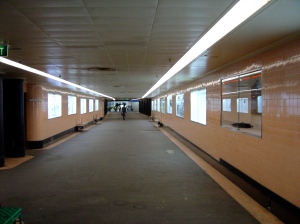Has it only been half a year since Platform closed and the dozen glass vitrines in the tile lined underpass at Flinders Street Station were left empty? The artist-run initiative Platform ran the space for twenty years and I regularly wrote about their exhibitions. Now Melbourne City Council’s Creative Spaces program have taken over management of the dozen vitrines in Campbell Arcade. They have rebranded them The Dirty Dozen because, as Creative Spaces’ Eleni Arbus puts it, ”It’s a pretty grungy site”.
The Dirty Dozen brings a new direction for the vitrines, filling them with the work of what Eleni Arbus calls “creative practitioners” rather than artists. Hopefully this will make the exhibitions more engaging for the commuters who use the underpass. The work of many contemporary artists failed to produce site specific art and failed to speak to the thousands of people who continued walking past.
The first exhibition at The Dirty Dozen, Prevaricated Frequencies by Skunk Control, a team of engineers and scientists from Victoria University demonstrates what Arbus means by “creative practitioners”. The vitrines were full of a forest of animatronic blooming flowers and caves of crystals, both with prismatic light effects from rotating polarised screens. Another vitrine contains a motorised kaleidoscope and another, rotating tanks of liquid. The attention to detail to create these complete other worldly visions is impressive.
Parts of this exhibition is similar to what was seen in Rose Chong’s display window last year when Skunk Control won the People’s Choice award at the annual Gertrude Street Projection Festival for Pestilent Protrusions. That People’s Choice award is an indication of engaging beauty that Skunk Control produce. The elegant engineering and science are used to present engaging and intriguing work rather than lecturing the audience.
Skunk Control was formed in 2012 by Nick Athanasiou a lecture at Victoria University in the College of Engineering and Science. There are a surprising number of engineers in Melbourne creating exciting art, including the street artist CDH. I wish that more artists today, instead of doing their Masters or Doctorates in Fine Arts, studied something else, something apparently unrelated to their art, because this would improve both the content and the art. I am looking forward to seeing what other “creative practitioners” will next be exhibiting at The Dirty Dozen.





July 11th, 2015 at 12:25 PM
Beautiful and exciting work by Skunk Control, thanks for reviewing the exhibition.
I think what you are suggesting about artists continuing studying in areas outside of traditional art is a ground breaking idea. The Saturday Paper talked about the new Creative Victoria taskforce (Steve Dow, June 13th, 2015) changing the name of Arts Victoria to Creative Victoria to allow for a broader definition. If art was integrated into every level of society and promoted as such, we would be a lot closer to creating culture in colonial Australia. I’ve been really impressed on repeated visits to Melbourne over the last 30 years to see the transformation from a manufacturing state to a vibrant and highly influential arts hub.
July 11th, 2015 at 5:29 PM
I really think that artists have become too specialised and that artists may no longer be the best people to create visually interesting and engaging work. Not that we need to integrate art more into society but that the liberation that modern art achieved means that anyone and not just artists can create ‘art’ (whatever that now means). There are various political/economic issues behind the switch between ‘arts’ and ‘creative’ labels (marketing is a creative industry, just as games design) but that’s another issue compared to ‘culture’.
July 11th, 2015 at 9:16 PM
Is there a place for art schools now then? I come from a craft background so the emphasis was on specialising to build the craftsmanship of the work and then make a niche industry in that area. Fine while that area lasts but it’s also a good way to dig yourself into obsolescence, or in the case of art, irrelevance. If anyone can now create art I would still like to see it properly resolved.
Ah, OK, I wasn’t thinking of economics or politics.
July 12th, 2015 at 12:58 PM
I would like to see a culture where there was less product from art schools and more from other sources. These other sources can include other types of training besides art schools, e.g. engineers can create elegant solutions to visual problems. The increase in the number of sources would make the culture more resilient, rather than, as you point out, specialisation creating the possibility for obsolescence through irrelevance.